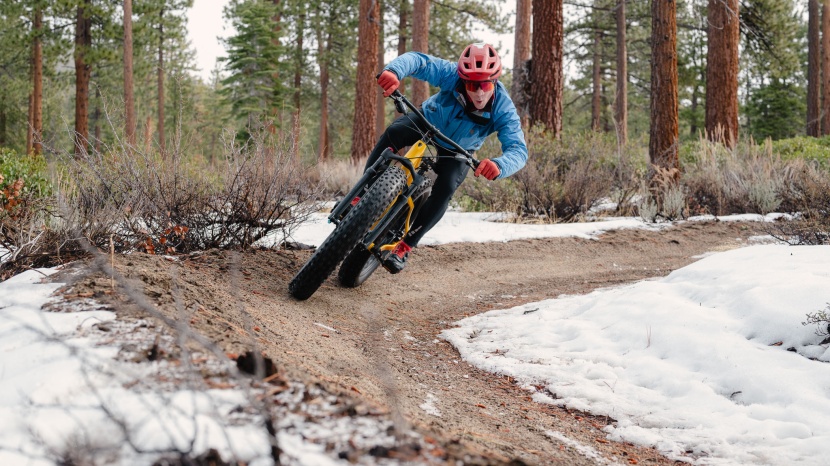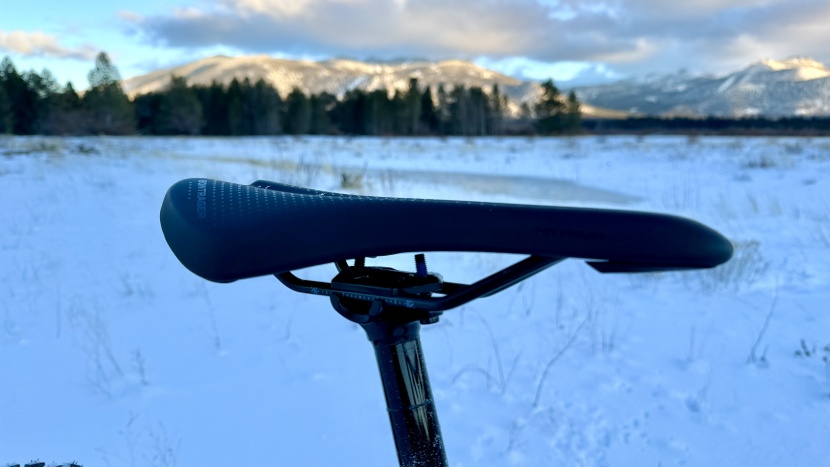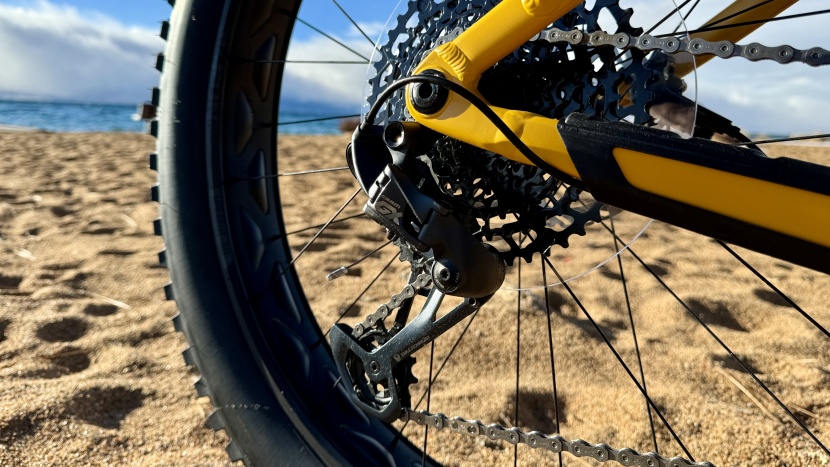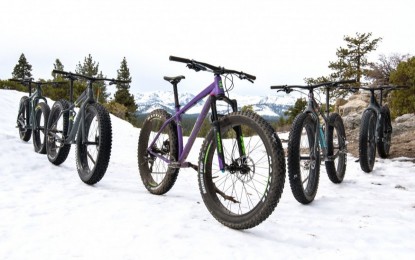
Our Verdict
Our Analysis and Test Results
Trek bills the Farley 7 as “a trail bike first and a fat bike second, ” and you feel that trail bike vibe with this bike; it's fun to ride. In our testing, the Farley impressed us with its performance and earned excellent scores in our testing metrics. It's certainly not the lightest or most agile fat bike in the review, but it excels on the trail and opens up possibilities. This trail crusher takes care of business in a somewhat understated manner, keeping the rider composed where others faltered. Testers agreed that this bike shreds downhill exceptionally well, is competent enough on the climbs, has an impressive build, and is a bit more fun than the others.
Downhill Performance
Undoubtedly, having a dropper post and a suspension fork give this bike enhanced descending capabilities; they also make it more enjoyable. The Farley 7 is the most capable and confident descender we have tested. Whether you are recklessly bombing a snowy fire road or shredding down a singletrack, this bike can stand up to higher speeds and a healthy dose of chop.
Fat bike geometry has significantly less variance when compared to traditional mountain bikes, but its appropriate for the narrower speed range they operate in. The outgoing Farley had a 69-degree head tube angle, and this bike sits at 67.7 degrees with its 80mm suspension fork. This gives the bike a bit more stability and confidence on faster or steeper terrain. The slacker head tube angle calms the bike's nerves, but it's still steep enough to feel responsive at lower speeds.
The wheelbase on our large test bike is fairly long at 1182mm and is no longer adjustable as it was on past models. Chainstay length is now a static 450mm, keeping the rear end tight but allowing plenty of clearance around the bottom bracket. The Farley 7 felt quite comfortable blasting single track; you never forgot you were on a fat bike, but its increased capabilities equal increased fun. It crushes chopped-up snow, deep footprints, ski tracks, and the underlying terrain. One of the most important attributes of the 4.5-inch Gnarwhal tires is the ability to run ultra-low pressure; Bontrager's flagship snow tire features a 120tpi casing, making it more supple than others. We rode them set up tubeless at 7 PSI in the front and 8-9 PSI in the rear. These low pressures enhance traction and add some damping to the ride. The 80mm Manitou Mastodon fork brings comfort and confidence to the front end. This was one of the most comfortable fat bikes we have ridden, especially at higher speeds.
The Farley has heroic cornering abilities, given its size and mass. The contact patch on the Gnarwhal is almost absurdly large, dotted with aggressive tread, siping, and stud-able holes. We loaded up our tires with studs and charged the nastiest sub-zero conditions; the grip provided by the studs is incredibly confidence-inspiring. Riders who experience icy conditions regularly are encouraged to try studded tires. The bike's long wheelbase makes it feel long at slow speeds but feels quite manageable when working through uphill corners. It reacts well to the dip of a shoulder and dives into turns fairly easily. Given the enormous tread; this isn't the most nimble fat bike in our review. If your trails feature lots of tight turns and technical moves, this bike might feel a bit cumbersome, though that is true of most fat bikes.
Uphill Performance
The Farley 7 is a respectable climber, though its heavier weight holds it back a bit. We found it was particularly impressive working up gradual to moderately pitched climbs in snowy and mixed conditions. It isn't going to win any races up the hill, but it offers superb traction and a relatively comfortable climbing position.
The 73.2-degree seat tube angle puts you in a relatively comfortable seated pedaling position. When perched in the saddle, our testers were not directly on top of the cranks but a little behind. On typical fat bike terrain, this position feels reasonably efficient for cruising along flatter terrain or gradually pitched climbs. We found that when we got out of normal fat bike terrain and tried to climb anything steep, our weight felt too far back, behind the rear axle, which made the front end wander. To solve this, we dropped the stem/handlebars by 20mm by adjusting some spacers and found the lower front-end height conducive to faster/more efficient climbing. If you keep the bike to snow service, you'll probably find the seat tube angle ideal.
According to the numbers, the Farley 7 is heavy; no two ways about it. When we hung our size Large test bike on our scale, we were surprised to see that it weighed 38 pounds and 2 ounces with tubes installed and no pedals. It certainly doesn't feel like a featherweight, but it doesn't have a particularly heavy feel on the trail. Sure, you won't be setting any uphill speed records on it, but its weight never felt excessive while riding. We don't consider a fat bike's weight to be as important as with other types of bikes, but those concerned with weight may be discouraged by these digits.
The 4.5" Bontrager Gnarwahl tires deliver excellent climbing traction, but they're also 1515 grams before adding 216 metal studs (about 60 grams) to each tire. Whether standing up and grunting up a steep snowy pitch or spinning it out over dirt, they hook up extremely well. The low tire pressures allow the tire casing to conform to the trail over an enormous area. All of that grip can make the bike feel lethargic and loud rolling at times. The SRAM GX/NX Eagle drivetrain works incredibly well; a 30T chainring connects to a 50t climbing gear to claw your way up any incline.
Versatility
Versatility proved to be a little bit of a double-edged sword with the Farley. On the one hand, the suspension fork and dropper post made this bike more capable on rougher and rowdier trails. On the other hand, a slightly more slimmed-down bike might be a better choice for buyers seeking snow and trail bike capabilities. For those riders, Trek offers the paired down Farley 5 for several hundred dollars less. Trek also offers a new carbon fork with a shorter offset for improved handling; it has a custom crown rack mount and triple bottle bosses low on the legs.
When considering the versatility of a fat bike, there is more to consider than snow vs. singletrack. Fat bikes can also make great bikepacking or adventure riding rigs, as the high-volume tires add an element of comfort and dampening. The new Farley is particularly well-designed for racks, bags, and accessories; it could easily be made into a full-fledged bike-packing rig with accessories from Trek's website, or you could opt for the Farley 9 that comes with custom racks, a fender, frame bags, and drybag holders.
Build
The Farley 7 is built around a custom-shaped Alpha Platinum Aluminum frame. It features internal routing for the derailleur and dropper post, top tube bag mounts, strapless full frame bag mounts, a downtube fender mount, a lower downtube accessory mount, seat stay rear rack mounts, and a Universal derailleur hanger. The Manitou Mastodon fork offers 80mm of travel and features compression damping and rebound adjustments. While 80mm may not sound like much travel, it does wonders to increase comfort and is critical to the bike's trail capabilities. The 150mm Tranz-X dropper post gets the saddle down and out of the way, further enhancing its downhill comfort and capability. Riding steep or technical terrain is not only easier but funner. Dropper posts are size specific, with the Small bike getting 100mm of drop, the Medium 130mm, and the Large and XL getting 150mm.
The SRAM GX/NX Eagle drivetrain is a dutiful performer. There's nothing flashy or particularly lightweight, but it offers a wide gear range and very reliable shifting. Trek chose SRAM's GX derailleur, NX cassette, and NX shifter for this build; the shifter is particularly welcome as it shares the same mounting and ergonomics as their higher-end models.
The Farley 7 rolls on a set of SunRingle Mulefoot 80 SL rims laced to Bontrager hubs. The wheelset seems almost ubiquitous on fat bikes in this price range, but Trek offers something extra. The rear hub is Bontrager's RapidDrive 108 freehub, with, you guessed it, 108 points of contact resulting in super quick engagement. That rapid engagement is a nice feature on any bike and an impressive spec on a bike in this price range.
Some of the less stellar specifications include the SRAM Level T brakes. They work fine, but the levers have a cheap feel and aren't as ergonomic as nicer brakes, but you probably won't notice through gloves. The bar/stem combination felt a bit off to us; the narrow-ish 750mm handlebar is 70mm beyond the steerer. We'll likely install a slightly shorter stem and wider handlebars as the bike goes into long-term testing.
Geometry
Trek updated the Farley's geometry but only made fairly conservative changes, which is good. Fat bike geometry isn't going through rapid changes like trail mountain bike geometry has. Our last Farley had a 69-degree head tube angle paired with a 631mm effective top tube and 455mm chainstays. The new Farley measures 67.7 up front with a 635mm effective top tube and 450mm chainstays. Those numbers create a moderate length 1182mm wheelbase. The effective seat tube angle is 73.2 degrees, and the reach measurement is 452mm. Our lead tester is 5'10" and, using Trek's recommended sizing ordered the size large and found the sizing perfect.
Should You Buy The Trek Farley 7?
The Trek Farley 7 is an obvious choice for the rider who wants the enhanced comfort and control that front suspension and a dropper post provide. You'll pay more for these luxuries, but you'll get a ride that doesn't hold you back when the snow runs out or the trail gets rough. The extra dollars buy you the versatility of a bike that is fun to ride in more conditions and maybe even more seasons.
What Other Fat Bikes Should You Consider?
If you don't feel a suspension fork is necessary, the Fezzari Kings Peak Comp would be our choice. This bike is confident and composed in downhill situations with its more progressive geometry; it weighs 7 pounds less than the Farley, it has loads of frame and fork mounts for bottles and bags, and it costs less, too. Interested in spending even less? The rigid-framed Salsa Heyday is an enjoyable fat bike, and while not as comfortable as the Farley, it's still a blast to ride for about half the price.
| Awards | Best Overall Fat Bike |
|---|---|
| Price | $2,999 List |
Overall Score  |
|
| Star Rating | |
| Bottom Line | A versatile fat bike that performs well across the board but really shreds downhill |
| Pros | Suspension fork, dropper post, studdable tires, versatile attachment points |
| Cons | Somewhat expensive, hefty, a bit clumsy in tight spaces |
| Rating Categories | Trek Farley 7 |
| Downhill Performance (30%) | |
| Uphill Performance (30%) | |
| Versatility (25%) | |
| Build (15%) | |
| Specifications | Trek Farley 7 |
| Wheelsize | 27.5" |
| Weight w/o pedals | 38 lbs 2 oz |
| Frame Material | Alpha Platinum Aluminum |
| Frame Size | Large |
| Available Sizes | S-XL |
| Fork | Manitou Mastodon 34 Comp |
| Wheelset | SUNRingle Mulefut SL 80 rims with Bontrager hubs |
| Front Tire | Bontrager Gnarwhal Team Issue 4.5" |
| Rear Tire | Bontrager Gnarwhal Team Issue 4.5" |
| Shifters | SRAM NX Eagle |
| Rear Derailleur | SRAM GX Eagle |
| Cranks | SRAM X1 1000 Eagle DUB |
| Chainring | 30T |
| Bottom Bracket | SRAM DUB BSA 100 |
| Cassette | SRAM PG-1230 11-50T |
| Saddle | Bontrager Arvada 138mm |
| Seatpost | TranzX JD-YSP18, 150mm |
| Handlebar | Bontrager Alloy, 750mm |
| Stem | Bontrager Elite, 70mm |
| Brakes | SRAM Level T |
| Head Tube Angle | 67.7-degrees |
| Reach (size Large) | 452mm |
| Wheelbase (size Large) | 1182mm |
| Chainstay Length | 450mm |
| Seat Tube Angle (effective) | 73.2-degrees |
| Warranty | Lifetime |




















